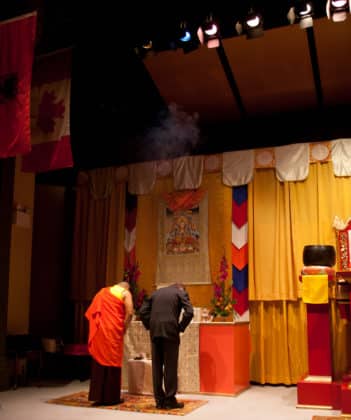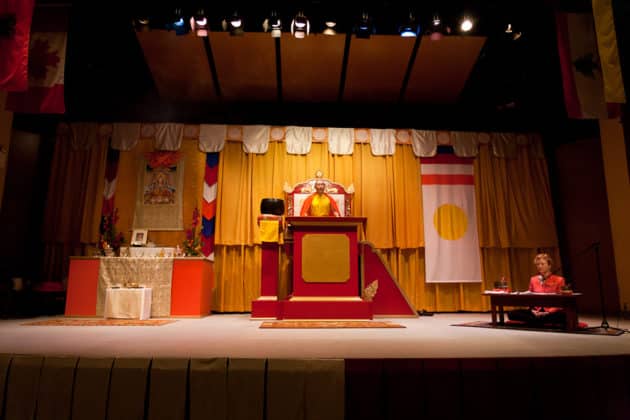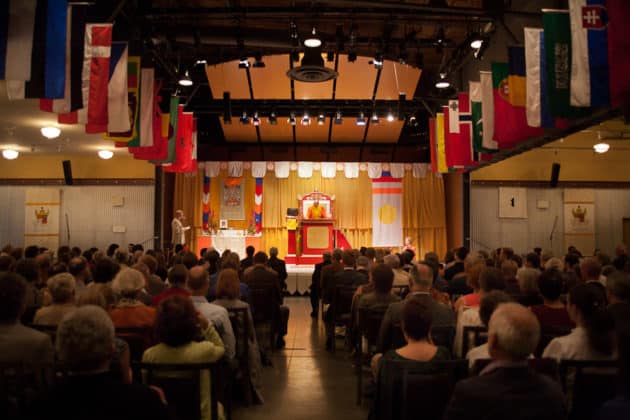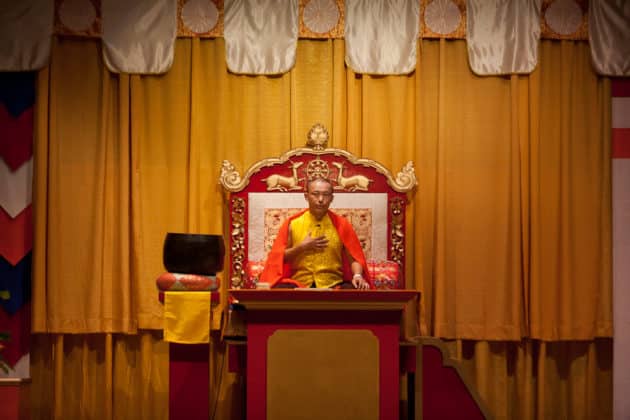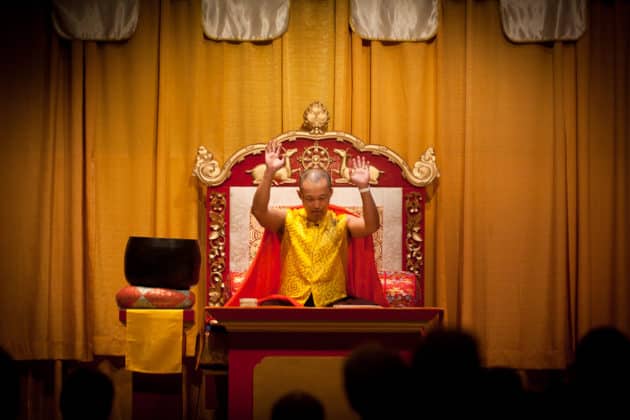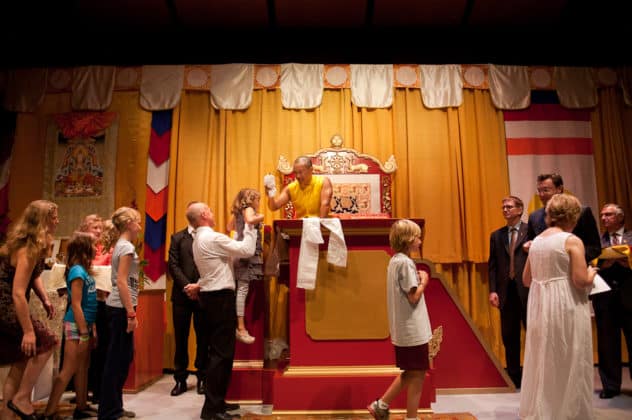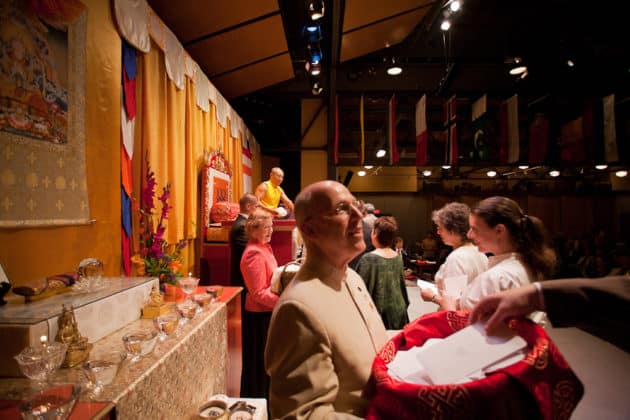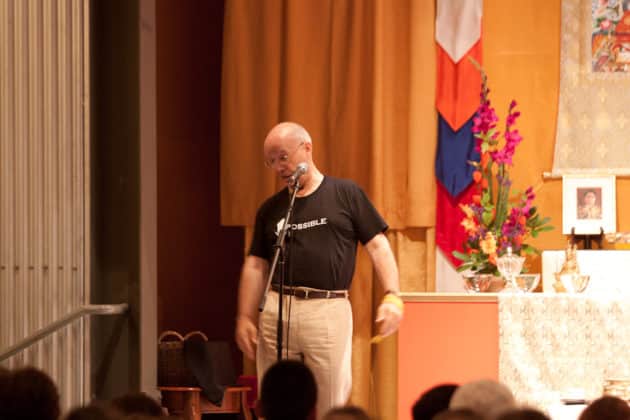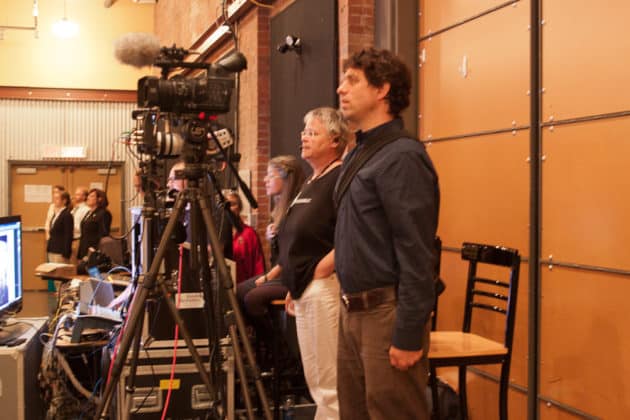by David Whitehorn
Post 1: 7am, Saturday, September 24, 2011 The shore of the Northwest Arm, Halifax, Nova Scotia, Canada
The water of the Northwest Arm is calm and quiet. A thin fog decorates the shoreline. On the hill above, silent low gray clouds hide the stately towers of Dalhousie University.
This morning, in this place, where Chögyam Trungpa Rinpoche passed away nearly twenty-five years ago, and which he saw as fertile ground for the emergence of enlightened society, there is a sense of peaceful expectation. It is the autumn equinox and the first Shambhala Lineage Festival is about to unfold.
Post 2: 12 noon, Halifax Shambhala Centre
When we arrived at 9am the skies were gray. Now it has started to rain. It was an interesting morning. The shrine room was filled, perhaps 125 people. At first there were three generations, but soon those under 14 years of age left to enjoy their own gathering, a banquet, in the Snow Lion Room. Those remaining spanned the years in age and in duration of involvement, as well as in our roles within Shambhala Society (with President Reoch, Kasung Acharya Mitchell Levy and Sangyum Wendy Friedman in the front row). For a time, we practiced together in relaxed silence. Mark Nowakowski then oriented us to the new Shambhala chant book and reminded us that chanting is a skillful way to mix our minds with wisdom. After a short break Acharya Christie Cashman led us through the Shambhala Vow and the Enlightened Society Vow, copies of which we all were given upon entry. Picking out key lines she wove together quotes from the Druk Sakyong with her own decades of practice and study to illuminate the continuity of the Sakyong Lineage. Comments and questions from those assembled added examples from everyday life. At the end of the morning, in dyads, reflecting upon our experience, I was personally struck by the power of the vows to express the pith of the Shambhala teaching. Leaving the shrine room, friends chatting, the afternoon free. Time to rest before gathering in delegs for a salon.
Post 3: 8:30pm, leaving the Shambhala Salon
I once researched the term “salon” and found it referred to small gatherings originally in Italy and France in the 16th-18th centuries, usually hosted by a wealthy patron, bringing together people for the purpose of education and entertainment. In a letter entitled “Shambhala Salon” the Sakyong encouraged us to gather as part of the Lineage Festival and view our conversations as a way of practicing enlightened society.
In Halifax we have a system of delegs, neighborhood groups, a form of social organization first established by the Druk Sakyong in Boulder, Colorado in the 1970s. It has been traditional for Delegs to gather on major Shambhala holidays, so, in some sense, the Shambhala Salon was a familiar form. A few emails circulated during the week. Someone offered their home. Everyone brought food to share. Forty people turned up. The attraction of Deleg gatherings is always the opportunity to chat with people and find out how their life, and the lives of their family, are unfolding. This very simple, very basic interaction seems as well to be very much to the point of how enlightened society operates. People are naturally and genuinely interested in one another. It feels good to have those kinds of ongoing relationships. Of course we have our differences in style and there can be irritation as part of some of the conversations. But somehow the environment of the Deleg gathering supports a sense of openness and caring. To begin the Salon, our Dekyong (the leader of the Deleg, chosen periodically by spontaneous insight of the Deleg members) read the Sakyong’s letter aloud. After a few minutes of silent contemplation we moved on to the food and the conversation. In changing groups of two, three, four or five, sitting on the floor, sitting in chairs, or standing, the evening unfolded. Laughter in the kitchen, mosquitoes on the back deck. No big deal. No big insights. Yet underlying it all was the Sakyong’s suggested theme for the salon: how can basic goodness become a socially binding principle
Leaving the house we find the rain has stopped. The night air is gentle and warm. A thick fog is beginning to fill the Northwest Arm.
Post 4: Sunday, September 25, 2011 (Day Two)
The day began with what Environment Canada likes to call “a mix of sun and clouds”. At first it is mostly clouds but as the day progresses it becomes mostly sun. By 12:30pm, as we drive down to the waterfront for the Shambhala Vow Ceremony, the sky is pure blue and the air is warm.
The ceremony will take place at Pier 21 on the Halifax harbour. One of a series of low buildings lining the south end of the harbour, Pier 21 is a National Historical site, for it is at this Pier that thousands and thousands of immigrants coming to Canada first arrived and were processed before dispersing throughout the rest of the country. Pier 21 is the Ellis Island of Canada. The building has been entirely renovated and, on the second floor, provides a crisp open meeting space that can easily accommodate over 500 people.
The area along the harbour near Pier 21 has recently been upgraded with the construction of the modern Halifax Seaport Farmers Market and a number of small shops and pubs.
This area is where the giant cruise ships dock that frequently visit Halifax throughout the summer and autumn, sending crowds of tourists into the city and surrounding sites for the day, leaving in the late afternoon or early evening to sail through the night to the next port of call.
Today, arriving on the waterfront we find that there are three huge and magnificent ships docked. The most impressive is the Queen Elizabeth, a classic ocean liner towering above the dockside buildings, stretching past the Farmers Market and nearly to Pier 21, berthed stern to stern with a gleaming Princess lines cruise ship, all windows and glass. A third, somewhat smaller cruise ship is berthed perpendicularly behind the Cunard Centre, the site for the recent Being Brave program and where, in years past the Sakyong Empowerment (1995) and the Royal wedding (2005) were held.
In front of Pier 21 there is a kaleidoscope of tourists off the cruise ships boarding buses and taxis, others simply wandering about, and a steady stream of Shambhalians entering and heading for the second floor meeting space in which the low raised platform at the front has been transformed into a Shambhala shrine room, complete with pristine shrine (with a single picture of the Druk Sakyong) and an impressive throne.
Soon the room is nearly full. Old friends, people we have never seen before, young, old, even a baby whose crying at times will likely be captured for posterity on the recordings of the event.
Video cameras and technical gear in the back of the room support the online streaming that will send the event to Shambhala Centres around the world.
The Sakyong arrives and ascends the throne. He gently and precisely leads us through the vow ceremony. Basic goodness and enlightened society; familiar words and concepts to contemplate, we vow our commitment and loyalty to the vision of a society that acknowledge and honors this most basic quality of humanity.
The result, the Sakyong tells us, is subtle, like a whisper that can become a breeze and then a wind, the shift to seeing ourselves, others and society as basically good. The impact of people together taking that view, who knows what tipping point might be influenced, perhaps just enough and just in time.
The Sakyong seems pleased. He says the Druk Sakyong likely would be as well. It is interesting to contemplate that these vows began in the Sakyong’s mind in deep retreat in Nepal in January and February 2011. Now, in just seven months the Shambhala organization has been able to create the time and space so that we can properly experience and engage with the vows, and with the Sakyong, on a global scale.
In future years, and future generations, who knows how many thousands or hundreds of thousands more will take these vows, each one who does will carry forward the Druk Sakyong’s vision, each one joining and supporting the lineage of Sakyongs that he began.
After the ceremony we sit in the outside patio of a waterfront restaurant. In full view the Queen Elizabeth sounds her deep thunderous horn three times and ever so slowly pulls away from the dock. She seems to be in no hurry, yet consistently gains speed and momentum, just like the Shambhala Lineage.
–Mountain Drum (David Whitehorn)




